Clancy Tucker's Blog, page 229
March 9, 2016
10 March 2016 - FAMOUS CHILD PRODIGIES
FAMOUS CHILD PRODIGIES
G'day folks,
Know any really smart kids? I sure do. However, here are some who became famous.
Wolfgang Amadeus Mozart
The Austrian-born wunderkind first took up the harpsichord when he was just 3 years old. He composed his first piece of published music at age 5, and by his teen years, he had already written several concertos, sonatas, operas and symphonies. Mozart and his sister Maria Anna—herself a musical prodigy—traveled widely through Europe exhibiting their talents in royal courts and public concerts. From Bavaria to Paris, audiences marveled at the boy wonder’s ability to improvise and play the piano blindfolded or with one hand crossed over the other.
During a 1764 stopover in London, he was even tested and examined by a British lawyer and naturalist named Daines Barrington, who was awestruck by the 8-year-old’s ability to sight-read unfamiliar music “in a most masterly manner.” Mozart would eventually grow into one of Europe’s most celebrated and prolific composers. Before his untimely death at age 35, he wrote more than 600 pieces of music.
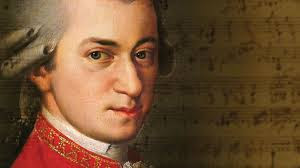
Enrico Fermi
Before his work on radioactivity won him the Nobel Prize and helped usher in the nuclear age, Enrico Fermi was considered a mathematics and physics prodigy. The Italy native showed signs of having a photographic memory as a boy, and by age 10 he was spending his free time mulling over geometric proofs and building electric motors. After his brother died unexpectedly in 1915, 13-year-old Enrico dealt with his grief by burying himself in books on trigonometry, physics and theoretical mechanics.
He then applied to the University of Pisa in 1918, wowing the admissions panel with a doctoral-level essay that solved the partial differential equation of a vibrating rod. Fermi achieved his post-secondary degree from the school several years early at the age of just 21. He later conducted groundbreaking experiments in neutron bombardment and nuclear chain reactions before becoming one of the lead physicists on the Manhattan Project—the secret research program that developed the atomic bomb.
Sor Juana Inés de la Cruz
Born in Mexico in 1651, Sor Juana Inés de la Cruz learned to read as a toddler and quickly blazed through all the books in her grandfather’s library. Despite being denied a formal education because of her gender, she began writing religious poetry at age 8 and later taught herself Latin, supposedly mastering it in just 20 lessons. By her adolescence, she had also studied Greek logic and learned an Aztec language called Nahuatl. Juana’s reputation for genius later won her a place as a lady-in-waiting at the viceroy’s court in Mexico City.
When she was 17, she was famously tested by a panel of 40 university professors, all of whom were shocked by her deep knowledge of philosophy, mathematics and history. The former child prodigy entered a convent at age 20 and spent the rest of her life as a cloistered nun. She continued her studies, however, and eventually established herself as one of the 17th century’s most popular authors of drama, poetry and prose. Her image now appears on the 200-peso bill in Mexico.
Pablo Picasso
As the son of a painter, Pablo Picasso had a brush in his hand from an early age. The future art legend could reportedly draw before he could talk, and his mother claimed that when he finally spoke, his first words were to ask for a pencil. Picasso made his first oil painting when he was 9 years old. His skills soon surpassed those of his father, and at age 14, he was admitted to a prestigious Barcelona art school. Just a year later, he completed “First Communion,” an astonishingly mature work that was displayed in a public exhibition.
The painting was among the first of the more than 22,000 artworks that Picasso would produce in his eight-decade career. “When I was a child, my mother said to me, ‘If you become a soldier, you’ll be a general. If you become a monk you’ll end up as the pope,’” he later said. “Instead, I became a painter and wound up as Picasso.”

Blaise Pascal
Born in 1623 in France, Blaise Pascal spent his youth being privately tutored at home by his father. The elder Pascal banished mathematics texts from the house to ensure the boy first focused on languages, but by age 12, young Blaise had secretly invented his own terminology and independently discovered nearly all the geometric proofs of Euclid. His mathematical genius only grew from there. At 16, he produced an essay on conic sections so advanced that the famed philosopher Rene Descartes was convinced his father must have ghostwritten it; by 19, he had designed and built a mechanical calculator known as the “Pascaline.”
Pascal went on to publish papers and conduct experiments on everything from fluid mechanics and perpetual motion to atmospheric pressure and the philosophy of religion. Before his death at the age of 39, he developed his famous “Pascal’s Wager,” which uses probability theory to argue for belief in God.


Clancy's comment: Mm ... There are some amazing facts here about some exceptional folks.


TOP REVIEW FOR 'KY!"
Here is a great review for one of my novellas, "KY!", written by Daan Spijer.
Clancy Tucker has written a delightful story of a teenage girl overcoming adversity. Rida is an immigrant, a Muslim, and is bullied at school because of the way she looks and because she is regarded as a nerd. She doesn’t fit in because she stands out. In the process of trying to avoid her tormentors, she meets people who assist her in unexpected ways.
Rida also meets Ky, another girl who doesn’t fit in and who has a secret that eventually turns Rida’s life around completely. This is a narrative very much of our time, dealing with issues of xenophobia and prejudice and how various people deal with these.
Clancy Tucker paints real people with real issues and brings it all together in a satisfying way. At only ninety-five pages, this is a book that can easily be read in one sitting and the reader will be richly rewarded for doing so.
© 2016 Daan Spijer
There ya go? Thank you, Daan, for taking the time to write a review.
Want a good read, head to the top right hand corner of this post and purchase a copy. You might just enjoy it.
I'm ...


Published on March 09, 2016 13:33
March 8, 2016
9 March 2016 - QUOTES FROM A FORMER AUSTRALIAN PRIME MINISTER

QUOTES FROM A FORMERAUSTRALIAN PRIME MINISTER
G'day folks,
Now, before you send me heaps of emails complaining about this post, let me reassure you that this is not a sick joke. No, these are real quotes from a man, Tony Abbott, who led a major political party in this country for five years. He was also Prime Minister for a time. God forbid!

“Abortion is the easy way out. It’s hardly surprising that people should choose the most convenient exit from awkward situations.” March 17th, 2004
“While I think men and women are equal, they are also different and I think it's inevitable and I don't think it's a bad thing at all that we always have, say, more women doing things like physiotherapy and an enormous number of women simply doing housework.” 2010
“The problem with the Australian practice of abortion is that an objectively grave matter has been reduced to a question of the mother’s convenience.” March 17th 2004

“We just can’t stop people from being homeless if that’s their choice.” February 11th, 2010
“Jesus knew that there was a place for everything and it’s not necessarily everyone’s place to come to Australia.” April 5th, 2010
“Why isn’t the fact that 100,000 women choose to end their pregnancies regarded as a national tragedy approaching the scale, say, of Aboriginal life expectancy being 20 years less than that of the general community?” March 17th, 2004
“What the housewives of Australia need to understand as they do the ironing is that if they get it done commercially it’s going to go up in price and their own power bills when they switch the iron on are going to go up.” February 8th, 2010

“The climate change argument is absolute crap, however the politics are tough for us because 80 per cent of people believe climate change is a real and present danger.” February 2nd, 2010
“I won't be rushing out to get my daughters vaccinated [for cervical cancer], maybe that's because I'm a cruel, callow, callous, heartless bastard but, look, I won't be.” November 9th, 2006
“I would say to my daughters if they were to ask me this question... [their virginity] is the greatest gift that you can give someone, the ultimate gift of giving and don't give it to someone lightly, that's what I would say.” January 27th
“The problem with the Australian practice of abortion is that an objectively grave matter has been reduced to a question of the mother’s convenience.” 2010

Clancy's comment: Great leadership, eh? What a bloody role model. What is it with these politicians? Can you believe that the same man is supposedly a devout Catholic, and is married with three adult daughters. Mm ...
I'm ...


Published on March 08, 2016 13:34
March 7, 2016
8 March 2016 - MALAYSIA

MALAYSIA
G'day folks,
Here is another country I'm posting in my series on countries worth visiting, courtesy of Travelfish. Malaysia is a Southeast Asian country occupying the Malaysian Peninsula and part of the island of Borneo. It's known for its beaches, rain forests and mix of Malay, Chinese, Indian and European influences. The sprawling capital, Kuala Lumpur, is home to colonial buildings, busy shopping districts such as Bukit Bintang and skyscrapers including the iconic, 451m-tall Petronas Twin Towers.
Stunning, ethnically diverse Malaysia is Southeast Asia's unsung holiday hero, offering travellers a huge range of attractions to choose from. Mix and match a trip that includes lush jungle trekking, chilling out on white-sand beaches, amazing snorkelling and diving, gastronomic adventuring and immersing yourself in a colourful cultural heritage.
With the bustling capital of Kuala Lumpur midway between the UNESCO-listed towns of Penang and Melaka, and also just a few hours by bus from the sprawling Taman Negara National Park, many of Malaysia's highlights are both affordable and easy to reach.
Whether you're a budget-minded independent backpacker or a tourist with cash to flash, Malaysia satisfies against an exotic backdrop of wafting call-to-prayers, eye-watering spicy street foods and the chatter of a friendly, cosmopolitan people. The Malaysian calendar is packed with festivals, so do your research and try to get here when one that appeals to your interests takes place.
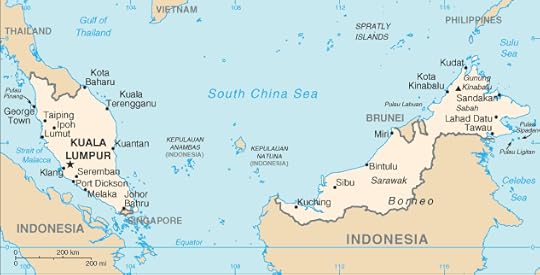
Malaysia tends to get unfairly shortthrifted by travellers to Southeast Asia. Backpackers imagine Cambodia, Laos, Thailand and Vietnam to be cheaper destinations and often leave Malaysia off their itineraries altogether – a grave mistake. While overall your cash may get you further in those countries, you can travel very well on a low budget in Malaysia and at the same time avoid the hordes of tourists you'll find on the well-beaten paths elsewhere. Malaysia also lacks the glamour many associate with the luxury resorts of Thailand, but unfairly so as the kingdom boasts some seriously bank-balance-busting destination hotels to rival the best in the region.
The country is geographically split in two. Peninsular Malaysia covers the entire southern portion of the Malay peninsula on mainland Southeast Asia and is home to 11 states plus Malaysia's two "capitals." Then there's less-populated Borneo, across the South China Sea, a huge and rugged island that Malaysia shares with Indonesia. It's worth covering ground in both parts as you'll want to see the natural wonders of the two states of Sabah and Sarawak on Borneo – choose from 23 national parks! -- as well as the array of more mainstream sights on the peninsula.
Kick off a visit to Malaysia in the capital proper, Kuala Lumpur, where towering skyscrapers, air-conditioned malls and a well-functioning road and public transport system will impress. The Singapore-like functionality is really the fruit of former leader Mahathir Mohamad's push to transform the once mostly agrarian nation into the developed world. These days young Malaysian designers lead the ongoing evolution in KL, as it's usually known, with funky bars and restaurants opening their doors to the stylish set.
Just south of KL is Melaka, the cradle of Malay civilisation. Relax to the chilled out vibe here and enjoy the gorgeous Dutch- and Portuguese-influenced architecture while getting to know Malaysian food, a delightful blend of Chinese, Malay and Indian influences.
The island of Penang off Peninsular Malaysia's west coast was once settled by the British and today the fascinating Georgetown boasts restored colonial architecture – and we reckon some of the region's best food (this despite the Brits).
To many people, Langkawi is to Malaysia as Phuket is to Thailand: Flash resorts and vast beaches plied by jet skis and yachts. It's not quite that simple however as you can do Langkawi on a budget, sort of. Those keener on low-key islands should head instead to Malaysia's east coast, where the Perhentians and Pulau Tioman beckon, offering superb snorkelling and diving -- or pop north of the border to Thailand's glorious Ko Tarutao island group.
Looking inland, Taman Negara is home to some of the world's oldest tropical rainforests and has plenty to keep nature lovers occupied, including Gunung Tahan, Peninsular Malaysia's highest peak. The park, established in 1938, is an island of environmentalism in what is otherwise an ocean of palm plantations that has gobbled up much of Peninsular Malaysia.
While not in the same ballpark as Taman Negara, Cameron Highlands was once exquisite in its own way, but like many "green destinations" it has been ravaged by short-term and at times idiotic development. Still, it remains a laid back destination and offers a (relatively) chilly respite from the humidity plaguing the rest of the country, as well as more British history and influence: think high teas, golf and bird-watching.

Those looking for more untouched wilds however, should head to Malaysian Borneo -- the northern slice of massive Borneo. Sabah is the smaller of Borneo's two Malay states and offers the 4,101-metre high Mount Kinabalu to conquer -- Malaysia's highest peak -- as well as the interesting city of Kota Kinabalu and picture-postcard islands of Gaya and Manukan, and the diving meccas of Pulau Sipadan and Mabul, where glimpses of mammoth sea-bound animals come thick and fast.
Larger, wilder, and less touristed still, Sarawak is in fact the largest state in all of Malaysia and boasts one of its most enthralling capitals -- the old colonial relic of Kuching. Aside from being a fine destination in its own right, Kuching is also one of the best spots in Sarawak to use as a base for exploring the hinterland. The state is awash in national parks, including Bako and Gunung Mulu, and unlike Peninsular Malaysia much of it remains rainforested.

What not to missEat your way through Kuala Lumpur or Penang (or both). Swim with turtles on the Perhentian Islands. Explore the grandeur of Taman Negara National Park. Experience the diving and forested wonder that remains in Eastern Malaysia (Borneo).
When to goEastern Peninsular Malaysia and Malay Borneo see their wettest period between November and February. The west coast of the Peninsula sees the wet between May and September. The climate is hot and humid year round -- regardless of if it is raining or not!

TRAVELFISH

Clancy's comment: Yes, like many Asian countries, this one has many things to see and enjoy.The food is delicious, and the people are wonderful. Get there if you can.
I'm ...


Published on March 07, 2016 13:38
March 6, 2016
7 March 2016 - THE CHRISTMAS TRUCE IN 1914

THE CHRISTMAS TRUCE IN 1914
G'day folks,
It’s one of history’s most cherished stories of wartime camaraderie: Five months after the start of the First World War, more than 100,000 British and German soldiers on the Western Front called an informal ceasefire on Christmas Eve. Starting that night and continuing the next day, soldiers on both sides joined in singing songs, exchanging gifts and even enjoying a friendly soccer match. Hostilities resumed (and intensified) immediately afterwards, and the ceasefire would not be repeated, but the Christmas Truce of 1914 emerged as one bright moment amid the war’s unrelenting devastation. Now, recently discovered letters from a British officer who experienced the truce reveal new details about the events of Christmas Day 1914--including the fact that not everyone on the front lines agreed with the ceasefire.
Just after midnight on Christmas morning, the majority of German troops engaged in World War I cease firing their guns and artillery and commence to sing Christmas carols. At certain points along the eastern and western fronts, the soldiers of Russia, France, and Britain even heard brass bands joining the Germans in their joyous singing.

At the first light of dawn, many of the German soldiers emerged from their trenches and approached the Allied lines across no-man’s-land, calling out “Merry Christmas” in their enemies’ native tongues. At first, the Allied soldiers feared it was a trick, but seeing the Germans unarmed they climbed out of their trenches and shook hands with the enemy soldiers. The men exchanged presents of cigarettes and plum puddings and sang carols and songs. There was even a documented case of soldiers from opposing sides playing a good-natured game of soccer.
The so-called Christmas Truce of 1914 came only five months after the outbreak of war in Europe and was one of the last examples of the outdated notion of chivalry between enemies in warfare. In 1915, the bloody conflict of World War I erupted in all its technological fury, and the concept of another Christmas Truce became unthinkable.
As the UK’s Daily Mail reports, Major John Hawksley of the Royal Field Artillery wrote to his sister Muriel at her home in Coatham Mundeville, near Darlington, describing the Christmas Truce as it played out in his position on the Western Front. According to Hawksley, at least one British regiment flatly refused to take part in the ceasefire. As he writes: “The Seaforths…would have none of it and when the Germans in front of them tried to fraternise and leave their trenches, the Seaforths warned them that they would shoot.”

Although Hawksley himself expressed discomfort with the truce in his letter–stating “This is an extraordinary state of things and I don’t altogether approve of it”–he also wrote in more detail of the camaraderie that blossomed between the two sides during the ceasefire. He described British and German soldiers on Christmas Eve “whose trenches were only one or two hundred yards apart” singing “Home Sweet Home” in English together, then “God Save the King.” The next morning, as it grew light, “each side showed itself above the trenches…until a German got out of his trench and then an Englishman did.”
All in all, according to Hawksley, about 100 Germans and 60 Englishmen, including officers, stepped out of the trenches and interacted near his position. He also wrote that a football match between the two sides was also arranged for Boxing Day (December 26), but was canceled once they learned that shelling from the British “big guns” was due to commence.
Hawksley was already a decorated veteran by Christmas 1914, having been awarded the Distinguished Service Order for his service during the retreat from Mons the previous August. In 1916, he was killed by sniper fire and buried at Becourt Military Cemetery in France. His letters to Muriel are scheduled for auction at Bonhams in London on June 19, where they are expected to sell for some £4,000, or around $6,100.
Hawksley’s are only the most recent letters to reveal details of the extraordinary truce that took place at Christmas of 1914 on the Western Front. Last year, Englishman Rodney Barker discovered a letter from his uncle, Staff Sergeant Clement Barker, featuring details about the ceasefire and the legendary football (soccer) match that took place during the Christmas Truce. Writing four days after Christmas 1914, Barker described how a German messenger made his way across No Man’s Land on Christmas Eve to negotiate the ceasefire. British soldiers were then able to recover the fallen bodies of their comrades from between the lines and bury them. The impromptu football match broke out when British soldiers kicked a ball from their trenches into No Man’s Land.

The experience of the truce apparently left Barker optimistic about the possibility for lasting peace. He wrote that “We have conversed with the Germans and they all seem to be very much fed up and heaps of them are deserting….Some have given themselves up as prisoners, so things are looking quite rosy.” In fact, the war would grind on for another four years, costing nearly 10 million lives, until an armistice was reached in November 1918. The unofficial ceasefire enjoyed that Christmas would never be repeated.
Even as such new details emerge about the extraordinary events of Christmas 1914, plans are in the works for a centennial commemoration of the truce. The British government is cooperating with the National Children’s Football Alliance on efforts to hold a commemorative international football match in Flanders as part of an extended series of events marking the 100th anniversary of key moments in World War I.

Clancy's comment: Mm ... I actually wrote a short story about a real truce during the next big war. Might post it here one day. True story too.
I'm ...


Published on March 06, 2016 14:31
March 5, 2016
6 March 2016 - AUSTRALIAN OPALS

AUSTRALIAN OPALS
G'day folks,
Ever seen an opal? Keep reading. They are one of the greatest natural delights on earth. Visitors to South Australia from 25 September will have the chance to go back in time 100 million years to a time when dinosaurs roamed Australia, the southern desert was a huge inland sea populated by huge Mesozoic monsters and some of the world’s most wondrous gemstones began being formed.
Opals, a multimillion dollar exhibition by the South Australian Museum will be a once-in-a-lifetime chance to see some of the rarest, most beautiful and spectacular opals ever discovered in Australia.
The exhibition’s star attraction is the Virgin Rainbow, described by museum director Brian Oldman as ‘the most wondrous and unique opal yet discovered’.
Also on display will be an opalised skeleton of one of the aforementioned monsters – a 6.5m plesiosaur – which died as the inland sea dried up.
The creature – the marine reptile equivalent of a dinosaur – is named the Addyman Plesiosaur, after its finders.

Ancient climate change
The Addyman Plesiosaur was opalised when water and silica hardened in its bones over millions of years.
Meanwhile the South Australian desert became a desolate moonscape above the plesiosaur’s forgotten carcass thanks to climate change in the Cretacious, around 100 million years ago.
It was found by a husband and wife pair of amateur prospectors in 1968 on almost their first day on the job.
But back to the centrepiece of the exhibition, the 6cm long Virgin Rainbow, which is worth over $1 million and is on display for the first time to celebrate the 100thanniversary of the beginning of opal mining in Australia.
‘’If you take the Virgin Rainbow – it’s almost as if there were a fire burning in there because the movement and the colour changes are constant,’’ Oldman said.
‘’It is perpetually different – not just if it’s under different light or the way you hold it, but because of the way the shapes inside refract the light.’’
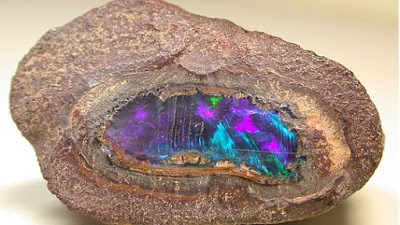
It is believed the Virgin Rainbow formed from the pocket left by the bone of a dead belemnite – a long extinct form of squid that possessed an internal skeleton.
The gemstone, which seems to breathe a multi-hued fire of reds, gold, greens and black, was discovered in Coober Pedy by opal miners John Dunstan, Tania Burke and Dale Price in 2003.
‘‘You’ll never see another piece like that one, it’s so special. That opal actually glows in the dark — the darker the light, the more colour comes out of it, it’s unbelievable,’’ Dunstan told the ABC recently.
‘‘I’ve done a lot of cutting and polishing. I’ve been doing it for 50 years, but when you compare it to the other pieces that claim to be the best ever, this one just killed it.”

A tribute to the miners In addition to the amazing sights, visitors will be able to take in the smells of an authentic Coober Pedy opal mine and an immersive display that explores the science of opals.
“We gathered earth from Coober Pedy and put it in a mine that we recreated from a mould of an actual working mine as part of the exhibition,” said Oldman.
“So you even get the smell of what it was like to be a miner – we have created an immersive experience.
“It’s a tribute to the ingenuity and dedication of the miners who gave their labour and even their lives so that we can admire these amazing gems.”
Oldman said the exhibition has quite literally been 100 million years in the making.
“That is how long it took opals to form, from when dinosaurs walked the Earth and central Australia was an inland sea.”
The museum has also gathered some of the most unique and fascinating opals from around the world to complement its own collection and showcase the beauty and diversity of Australia’s national gemstone.
“From jewellery to fossils, to specimens embedded in rock, visitors will be treated to a spectacle of unmatched colour and beauty,” said Oldman.
“A range of activities will be on offer throughout the exhibition to allow visitors to delve into the geology and history of opals and discover the science behind their signature play of colours.
“It will have a rich South Australian flavour, which is unsurprising given that 90 per cent of the world’s opals come from this state,” he said.
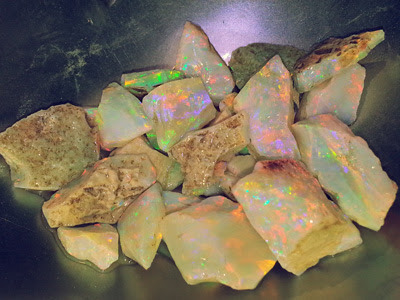
Finest gems gathered from around the globe
Oldman said the international collection is a testament to the strength of the museum’s global networks.
“It will feature a collection of a quality never before seen in one place – this is a once-in-a-lifetime opportunity.”
“It is quite simply the finest collection of opals ever assembled in one place and it’s unlikely that this collection of opals will ever be seen again.
“It tells the whole story of opals, from how they formed, the tenacity of the miners all the way through to the creation of opal jewellery.”
The first opal was discovered in 1914, when a boy named Willie Hutchison went on a gold mining expedition with his father.
“The story goes that Willie set out in search for water one day, rather than staying at camp as he’d been instructed to do by his father.”
“He came back to camp with water, but also with precious opal gemstones.”
Over time this led to the creation of opal mining communities in places like Coober Pedy, Andamooka and Mintabie, which have remained opal mining hubs to this day.
“It is ironic that in the most harsh of terrains the most beautiful of naturally occurring gems are now found.”

Proof of water on Mars
When the inland sea dried, acid levels in the top sandstone deposit were boosted, releasing silica that would later seep into the pockets left by the bones of long-dead plesiosaurs.
Later as acid levels rose the silica hardened into opals. No other environment in the world is known to have undergone this same process.
Interestingly, just as the presence of opal reveals inland Australia’s aquatic past, the discovery of opals on Mars confirmed the existence of water there long ago and expanded the timeframe when water existed on the Red Planet.
The NASA discovery back in 2008 suggested that liquid water remained on the planet’s surface a billion years later than scientists believed, and it played an important role in shaping the planet’s surface and possibly hosting life.

Clancy's comment: Trust me. An opal is worth seeing. I'm ...


Published on March 05, 2016 15:12
March 4, 2016
5 March 2016 - SAMMY DAVIS Jr.

SAMMY DAVIS Jr.
G'day folks,
Welcome to some facts about an American entertainer who came to Australia many times and was well loved. Samuel George "Sammy" Davis Jr. was an American entertainer. Primarily a dancer and singer, he was also an actor of stage and screen, musician, and impressionist, noted for his impersonations of actors, musicians and other celebrities.
His nickname was Mr. Show Business, but Sammy Davis Jr.fondly called himself "the only black, Puerto Rican, one-eyed, Jewish entertainer in the world." Although he stood at a mere 5’6” and weighed only 120 pounds, Davis’ 60-year-long-career left a massive impression on the entertainment world. He starred in seven Broadway shows, appeared in 23 films including Ocean’s Eleven, regularly landed television roles and recorded dozens of albums. Although he died of throat cancer at the age of 64, his memory lives on as one of the greatest pop culture icons of the 20th century. Here are seven interesting facts about Mr. Bojangles himself.
1) He lost an eye in a car accident.
On November 19, 1954, Sammy Davis Jr. was driving from Las Vegas to Los Angeles to record a soundtrack for the film Six Bridges to Cross. He never made it to the studio. Early that morning, his Cadillac collided with an automobile that backed out in front of him. He sustained massive injuries to his face, including a broken nose and damage to his left eye so severe that it had to be replaced with a plastic one. A consummate professional, he was back on stage only two months later.

2) He converted to Judaism. Life was different after Sammy Davis Jr.’s car accident. He believed that surviving the crash was a miracle and spent much of his recovery reflecting on his existence. While at San Bernardino hospital, he met a Jewish Chaplain and asked “a million questions about the miracle” of coming out of the accident alive. Although his parents were Christians, Sammy Davis Jr. was not deeply religious. But after learning about Judaism, he felt Jews and Blacks shared a similar history of oppression. Over the years, he studied more about the religion and eventually converted.
3) He held a grudge against JFK.
According to Davis’ 1989 biography, John F. Kennedyasked the entertainer not to participate in the 1961 Presidential inauguration, because the sight of the black entertainer alongside his wife, May Britt (who was white), would potentially anger Southerners. Being shunned by the president was a sore spot for SDJ, but those feelings were smoothed somewhat in 1987 when he was honored by the Kennedy Center.

4) He shared a bromance with fellow Rat Packer Frank Sinatra. During his teens, Sammy Davis Jr. first met Old Blue Eyes, when he helped open for the Tommy Dorsey Orchestra — and Frank. The two became lifelong friends, enjoying a palpable chemistry both on and off stage. In fact, Sinatra was like a big brother to Sammy. In one instance, Sinatra tore up his contract when a theater barred Sammy Davis Jr. because of his race. After SDJ had his car accident, Frank paid the medical bills. For Sammy, the admiration was mutual: “I wanted to be like him, I wanted to dress like him, I wanted to look like him, I took my hair and had it all done up, Sinatra style, with the little curl here and all.”
5. He had a difficult relationship with his daughter. It’s no surprise that the world’s greatest entertainer had a passion for his work, but that passion often strained his relationship with his family. In a memoir about her father, his daughter, Tracy Davis, said her famous dad missed her fifth birthday party, then tried to make it up to her by handing over a $100 bill. She also revealed that he skipped her college graduation and routinely lost track of her phone number. Although the two grew closer together later in life, for Tracy Davis, the scars remained. “I am not saying that he didn't love us, but work was his driving force,” she said.

6. He performed one of the most famous kisses on television. In 1972, the Rat Packer helped create one of TV’s most legendary moments — an on-screen kiss that appeared on the highly popular show All in the Family. The episode featured Sammy (as himself) visiting the Bunker household in order to retrieve a briefcase he left in Archie’s taxi. Although Archie makes several racist remarks throughout the show, Sammy keeps his cool and famously plants a smooch on Archie’s cheek before heading for the door. It was one of the show’s most famous episodes and went on to be nominated for two Emmys.
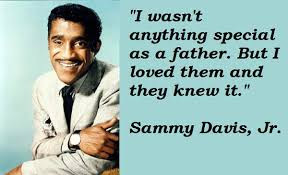
7. His adopted son was also his biological son. Or was he? Earlier this year, reports surfaced that one of Sammy Davis Jr.’s adopted sons was actually his biological son. Fifty-five year-old Mark Davis said he first learned he was adopted after reading a Life magazine article in the 1960s that said the entertainer had adopted Mark around the age of two. But in 2013, Mark found his original birth certificate which listed Sammy Davis Jr. as his biological father. Much to his disappointment, however, a DNA test showed that Sammy Davis wasn’t his biological father. Maybe the distinction didn’t matter to Sammy. According to Mark, his father’s last words to him from his deathbed were: “You are my son.”

Clancy's comment: This guy was one of the many Americans who repeatedly returned to Australia to perform.
I'm ...


Published on March 04, 2016 14:31
March 3, 2016
4 March 2016 - WHY DOES THE LEANING TOWER OF PISA LEAN?

WHY DOES THE LEANING TOWER OF PISA LEAN?
G'day folks,
Do you know the answer to this question? If not, read on, courtesy of Fabio Muzzi. The Leaning Tower of Pisa or simply the Tower of Pisa is the campanile, or freestanding bell tower, of the cathedral of the Italian city of Pisa, known worldwide for its unintended tilt.
Pick any day in the Piazza del Duomo in the Italian city of Pisa, and you will undoubtedly spot a bunch of tourists posing for the same photo: hands outstretched towards the cathedral’s conspicuously tilting bell tower, as if they are supporting it with their sheer strength. The so-called Leaning Tower of Pisa is one of the most famous buildings in the world, although maybe not for the reasons its original architects would have wanted.
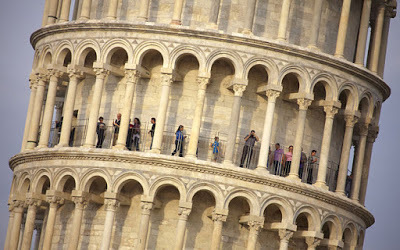
In 1173, construction began on a white marble bell tower for the cathedral complex in Pisa, located between the Arno and Serchio rivers in Tuscany, central Italy. By the time builders had finished the third of eight planned stories about five years later, the tower’s foundation had begun to settle unevenly on the ground beneath it, a dense mixture of clay, sand and shells. As a result, the structure had begun to tilt visibly toward the south. Shortly after that, war broke out between Pisa and Genoa, another Italian city-state, halting construction for nearly a century. This delay allowed the foundation to settle further, likely prevented the bell tower’s premature collapse.
When construction resumed, chief engineer Giovanni di Simone tried to compensate for the lean by adding extra masonry to the short side, but the additional weight caused the structure to tilt even further. The tower was officially completed around 1370, but its lean only increased over the next six centuries, becoming an integral part of the monument’s quirky appeal. Despite various attempts to reinforce it, Pisa’s tower continued to subside at a rate of some 0.05 inches per year, placing it in increasing danger of collapse. By 1990, it was leaning 5.5 degrees (or some 15 feet) from the perpendicular–the most extreme angle yet. That year, the monument was closed to visitors and the bells removed as engineers started extensive reparations to stabilize it.

By siphoning earth from beneath and adding counterweights to the tower’s north end, they were able to reduce the lean to 13.5 feet, or 4.0 degrees from perpendicular. The straightening continued after the tower reopened in 2001, and in 2008 sensors showed the subsiding motion had stopped, after a total improvement of some 19 inches. Engineers now believe the Leaning Tower of Pisa will remain stable for some 200 years, barring an earthquake or other unpredictable disaster.

Clancy's comment: There ya go. By the way, almost every body who has been there has taken a picture like the last photograph above.
I'm ...


Published on March 03, 2016 13:45
March 2, 2016
3 March 2016 - TOKYO ROSE

TOKYO ROSE
G'day folks,
Tokyo Rose was a generic name given by Allied troops in the South Pacific during World War II to what they believed were multiple English-speaking female broadcasters of Japanese propaganda. The next time you feel you just can't get a break in life, consider Iva Toguri D'Aquino, better known as "Tokyo Rose"...
Sixty-five years ago today on October 6, 1949, Iva Toguri D'Aquinobecame the seventh person in the history of the United States to be charged with treason. At the time her 13-week trial was the most expensive and longest trial ever recorded, totaling around $750,000 (by today's standards, over $5 million).
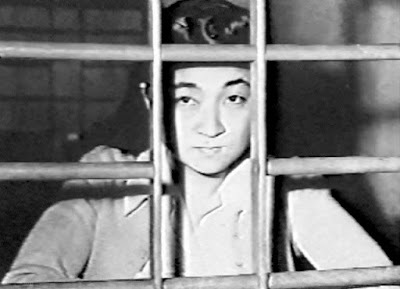
Despite being charged on eight counts of treason, D'Aquino ended up being convicted of one, the crime being that the radio broadcaster spoke "into a microphone concerning the loss of ships." With anti-Japanese sentiments still raw post-Pearl Harbor, U.S. authorities were hungry for retribution, and they found Japanese-American D'Aquino an easy target, accusing her of spreading anti-American propaganda on a Japanese radio station.
But before she was legally married in a San Francisco courthouse in 1949 — slapped with a $10,000 fine, a 10-year prison sentence, and stripped of her U.S. citizenship — D'Aquino had already suffered a great many hardships...all because she had a Japanese face and was in the wrong place at the wrong time.
Ironically, D'Aquino was as American as one could be. Born on Independence Day in 1916 in Los Angeles, she was raised in a middle-class household that spoke strictly English. Her father and mother embraced assimilation and offered their daughter a normal life; D'Aquino enjoyed going to church, was a popular student at school, loved swing music, and took tennis and piano lessons. In 1941, she graduated from UCLA with a degree in zoology.
D'Aquino wasn't the only "Tokyo Rose" − a term coined by South Pacific Allied troops, which referred to any English-speaking female broadcaster accused of spreading Japanese propaganda − but she was the most punished, among the dozen or so women who were given the label.

Here are five unfortunate life events that would seal her fate as the most notorious "Tokyo Rose."
1) Visiting her extended family in Japan to attend to a sick aunt, D'Aquino was denied re-entry into the U.S. once the Japanese bombed Pearl Harbor on December 7, 1941.
2) Refusing to renounce her U.S. citizenship, D'Aquino was labeled an enemy of Japan and was unable to receive a food ration card. Angered by her pro-American sentiments, her extended family banished her from their home.
3) In need of work, she eventually decided to become a radio broadcaster on a Japanese station show called the "Zero Hour." With her gravelly voice, she and her fellow expat co-broadcaster decided to mock the pro-Japanese propaganda-filled program. (Thankfully for their sake, the Japanese did not pick up on their nuanced sarcasm. . .but unfortunately, the U.S. didn't, either.) 4) By 1945 WWII was over, but the post-war battered economy compelled D'Aquino, who was still stranded in Japan, to take a chance and claim herself as the one and only "Tokyo Rose" — this, after a Cosmopolitan writer offered her $2,000 to share her story. Little did she know, she was tricked, and her story was interpreted as a confession. She was arrested, and U.S. authorities threw her into a Tokyo jail before she stood trial in America.
5) So what were the damning words that had a U.S. jury convict her of treason? She allegedly said in a 1944 broadcast on the "Zero Hour": "Orphans of the Pacific, you are really orphans now. How will you get home now that your ships are sunk?"
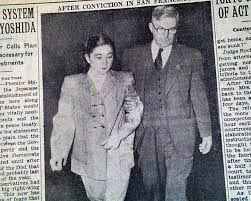
D'Aquino was released from prison after serving six years out of her 10-year sentence. Almost 40 years old, she had to find the strength to move on from her misfortunes, which included: losing about a decade of her life living on foreign soil; not being able to see her mother before she passed; losing her baby soon after giving birth, and eventually (albeit reluctantly) divorcing her Portuguese husband who was forced to never step foot on American soil.
After it was discovered that the witnesses who offered the most damaging testimony against D'Aquino were pressured to lie under oath, President Gerald Ford pardoned her in 1977. With her citizenship restored, she was allowed to be an American again.
Living quietly in Chicago, D'Aquino had wished her father could have lived to see the day of her pardon (he had died four years earlier in 1973). Still, she was proud to share what he had said to her about her harrowing journey: "You were like a tiger, you never changed your stripes, you stayed American through and through."

Clancy's comment: I wonder how many modern kids would know anything about this. Very few I guess.
I'm ...

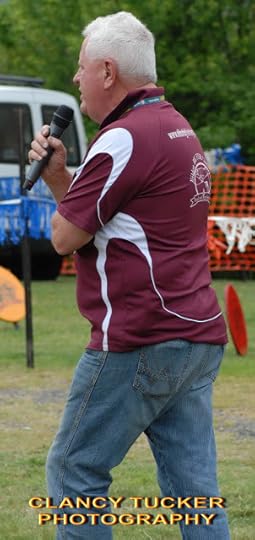
Published on March 02, 2016 15:29
March 1, 2016
2 March 2016 - THE AMAZING CLARK'S NUTCRACKER

THE AMAZINGCLARK'S NUTCRACKER
G'day folks,
Now, here is something very special, courtesy of National Geographic. Clark's nutcracker, sometimes referred to as Clark's crow or woodpecker crow, is a passerine bird in the family Corvidae. It is slightly smaller than its Eurasian relative the spotted nutcracker. It weighs only four or five ounces, its brain practically nothing, and yet, oh my God, what this little bird can do. It’s astonishing.
Around now, as we begin December, the Clark’s nutcracker has, conservatively, 5,000 (and up to 20,000) treasure maps in its head. They’re accurate, detailed, and instantly retrievable.
It’s been burying seeds since August. It’s hidden so many (one study says almost 100,000 seeds) in the forest, meadows, and tree nooks that it can now fly up, look down, and see little x’s marking those spots—here, here, not there, but here—and do this for maybe a couple of miles around. It will remember these x’s for the next nine months.
How does it do it?

32 Seeds a Minute
It starts in high summer, when whitebark pine trees produce seeds in their cones—ripe for plucking. Nutcrackers dash from tree to tree, inspect, and, with their sharp beaks, tear into the cones, pulling seeds out one by one. They work fast. One study clocked a nutcracker harvesting “32 seeds per minute.”
These seeds are not for eating. They’re for hiding. Like a squirrel or chipmunk, the nutcracker clumps them into pouches located, in the bird’s case, under the tongue. It’s very expandable …
The pouch “can hold an average of 92.7 plus or minus 8.9 seeds,” wrote Stephen Vander Wall and Russell Balda. Biologist Diana Tomback thinks it’s less, but one time she saw a (bigger than usual) nutcracker haul 150 seeds in its mouth. “He was a champ,” she told me.

Next, they land. Sometimes they peck little holes in the topsoil or under the leaf litter. Sometimes they leave seeds in nooks high up on trees. Most deposits have two or three seeds, so that by the time November comes around, a single bird has created 5,000 to 20,000 hiding places. They don’t stop until it gets too cold. “They are cache-aholics,” says Tomback.
When December comes—like right around now—the trees go bare and it’s time to switch from hide to seek mode. Nobody knows exactly how the birds manage this, but the best guess is that when a nutcracker digs its hole, it will notice two or three permanent objects at the site: an irregular rock, a bush, a tree stump. The objects, or markers, will be at different angles from the hiding place.
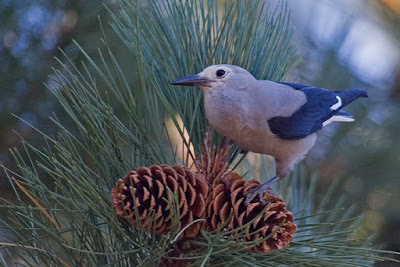
Next, they measure. This seed cache, they note, “is a certain distance from object one, a certain distance from object two, a certain distance from object three,” says Tomback. “What they’re doing is triangulating. They’re kind of taking a photograph with their minds to find these objects” using reference points.
Psychologist Alan Kamil has a different view. He thinks the birds note the landmarks and remember not so much the distances, but the angles—where one object is in relation to the others. (“The tree stump’s 80 degrees south of the rock.”) These nutcrackers are doing geometry more than measuring.
However they do it, when the snow falls and it’s time to eat, they’ll land at a site. “They will perch on a tree,” says Tomback, “on a low branch, [then light onto the ground, where] they pause, look around a bit, and they start digging, and in a few cases I’ll see them move slightly to the right or to the left and then come up again.”
She’s convinced that they’re remembering markers from summer or fall and using them to point to the X spot—and, “Lo and behold, these birds come up with their cracked seeds,” she says. “And it’s really pretty astounding.”
In the 1970s, Stephen Vander Wall ran a tricky little experiment. He shifted the markers at certain sites, so that instead of pointing to where the seeds actually were, they now pointed to where the seeds were not.
And the birds, as you’d expect if they were triangulating, went to the wrong place.
But at sites where he left the markers untouched, the birds got it right. That’s a clue that each of these birds has thousands of marker-specific snapshots in their heads that they use for months and months. When the spring comes and the birds have their babies, they continue to visit old sites to gather seeds until their chicks fledge.

The mystery here, the deep mystery, is how do they manage to store so much data in their heads? I couldn’t possibly do what they do (I can’t even remember all ten digits in a phone number, so I’d be one very dead nutcracker in no time). Is their brain organized in some unique way?
Is their brain plastic? Can it grow more neurons or more connections when it needs to? Chickadees are also food hiders, and they do grow bushier brains when they need to, expanding in the “remember this” season and contracting afterward. Do Clark’s nutcrackers do that? We don’t know.
Whatever it is they do, I want what they’ve got.

Clancy's comment: Stunning, eh? Hey, you might want to send this post to your kids and grand kids. I'm sure they will be gob smacked. Grateful thanks to National Geographic.
I'm ...

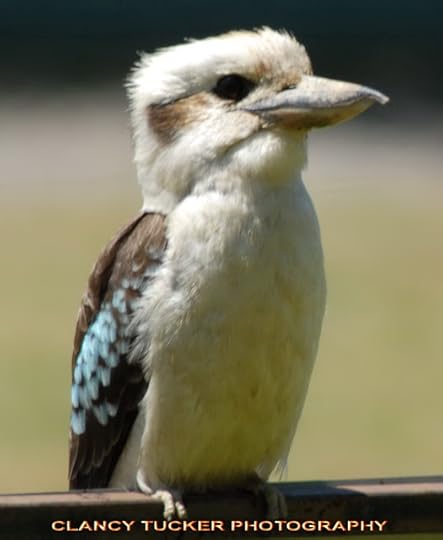
Published on March 01, 2016 16:26
February 29, 2016
1 March 2016 - WISE ADVICE

WISE ADVICE
G'day folks,
Time for some more great quotes.














Clancy's comment: I always love the humorous ones.
I'm ....

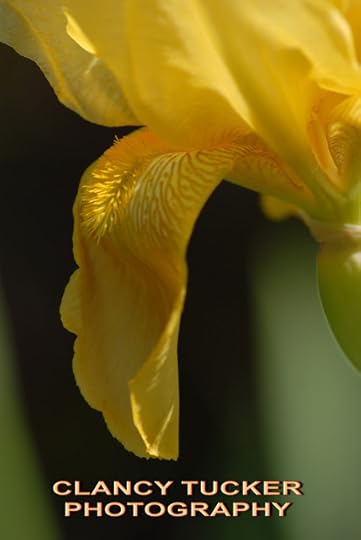
Published on February 29, 2016 16:37



